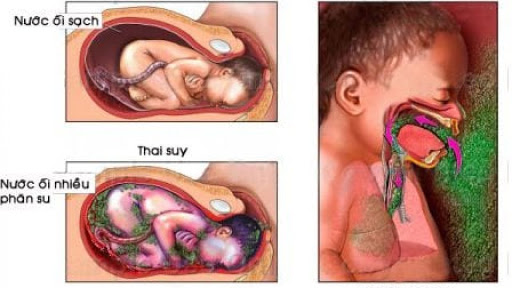Characteristics of amniotic fluid and common problems
Amniotic fluid is the sac that surrounds the fetus. Abnormal changes in color, odor and amniotic fluid content warn of dangerous diseases and complications for both mother and fetus. Therefore, pregnant women need to have regular antenatal check-ups according to the doctor's appointment to ensure the safety of the fetus and take early action if any abnormality is detected.
1. Characteristics of amniotic fluid
The maximum amount of amniotic fluid is around 34 weeks gestation (gestational age), averaging 800 mL. About 600mL of amniotic fluid surrounds the fetus at term (40 weeks of age). Accordingly, the amniotic fluid is continuously moving (circulating) through the baby swallowing, "breathing" and excreting the amniotic fluid.
Characteristic features of amniotic fluid include:
Amniotic fluid is usually clear to pale yellow. Amniotic fluid is odorless or has a slightly sweet smell The amount of amniotic fluid increases throughout pregnancy until about week 34, and then begins to decrease slightly. Amniotic fluid is made up of water, electrolytes, proteins, carbohydrates, lipids, phospholipids and urea, as well as fetal cells. The role of amniotic fluid includes:

Chọc ối giúp cung cấp các thông tin về sức khỏe và sự phát triển của thai nhi
The fetus moves in the womb, allowing the bones to develop properly Lungs developing properly Prevents pressure on the umbilical cord Keeps the temperature stable around the baby, protects from heat loss Protects the baby from injury outside or sudden movement Urine formation An abnormal amount of amniotic fluid will make the doctor observe the mother's pregnancy more carefully. Amniocentesis through amniocentesis will provide information about the health and development of the fetus.
MORE: What color is amniotic fluid? Common problems with amniotic fluid
2. Common problems related to amniotic fluid
2.1. Abnormal color of amniotic fluid Inhalation of meconium : When you are full term or near term, green or brown amniotic fluid is a sign that your baby has had a bowel movement (meconium). A change in color is a sign that the baby is in danger or that the pregnancy is simply long enough. Labor, stillbirth, placental problems: Signs are the amniotic fluid turning bright red or dark red.

Hình ảnh hít ối phân su
2.2. Abnormal smell of amniotic fluid A foul-smelling amniotic fluid is usually a sign of an infection. Women who have broken water at home should be brought to the hospital immediately if the amniotic fluid has a foul odor (which may or may not be accompanied by a fever).
MORE: Abnormal amniotic fluid, cloudy green, brown: Danger warning
2.3. Oliguria is the lack of amniotic fluid that often occurs in late pregnancy, rupture of membranes, placental dysfunction or fetal abnormalities (birth defects, kidney abnormalities). The amount of amniotic fluid is measured by ultrasound.
2.4. Polyhydramnios Polyhydramnios is an excess of amniotic fluid that often occurs with multiple pregnancies (twins or triplets), birth defects, or gestational diabetes. In some cases, the cause is not clearly identified. Polyhydramnios is diagnosed by fetal ultrasound.
2.5. Premature rupture of membranes (PPROM)

vỡ ối non
Complications such as infection, fetal distress, premature labor leading to premature birth can arise for both mother and baby if membranes rupture too early in pregnancy. Usually, the goal of treatment is to delay labor for as long as possible for the mother and fetus. Mothers with premature rupture of membranes will require hospitalization, bed rest, antibiotics and corticosteroids to speed fetal growth, slow labor, and increase the chances of fetal survival if premature birth.
Abnormalities in the volume and color of amniotic fluid can cause severe consequences for the health of the fetus as well as psychological anxiety for pregnant women. Therefore, in addition to a reasonable diet and adequate water intake, pregnant women also do not forget to have regular antenatal check-ups according to the instructions of the obstetrician, to detect early and promptly treat any abnormalities. can often occur during pregnancy.
Department of Obstetrics and Gynecology - Vinmec International General Hospital has solved many difficult cases such as: polyhydramnios, placenta accreta, knotted umbilical cord, premature pregnancy... Accordingly, to facilitate the pregnancy process Moreover, Vinmec has implemented PACKAGE Maternity Packages, including prenatal, perinatal and postpartum care services. Pregnant women are monitored and carried out all necessary tests and ultrasounds to detect pregnancy abnormalities early. The birth will be "gentle" like going on vacation, at the hospital, there are fully equipped for mother and baby.
Vinmec International General Hospital gathers a team of highly qualified doctors at home and abroad as well as the quality of ultrasound machine system, modern equipped medical equipment, main prenatal examination procedures. Accurately, science will handle abnormalities during pregnancy and labor quickly, helping women have the safest pregnancy.
Để đặt lịch khám tại viện, Quý khách vui lòng bấm số HOTLINE hoặc đặt lịch trực tiếp TẠI ĐÂY. Tải và đặt lịch khám tự động trên ứng dụng MyVinmec để quản lý, theo dõi lịch và đặt hẹn mọi lúc mọi nơi ngay trên ứng dụng.
References: verywellfamily, medlineplus.gov, sciencedirect.com
Bài viết này được viết cho người đọc tại Sài Gòn, Hà Nội, Hồ Chí Minh, Phú Quốc, Nha Trang, Hạ Long, Hải Phòng, Đà Nẵng.





